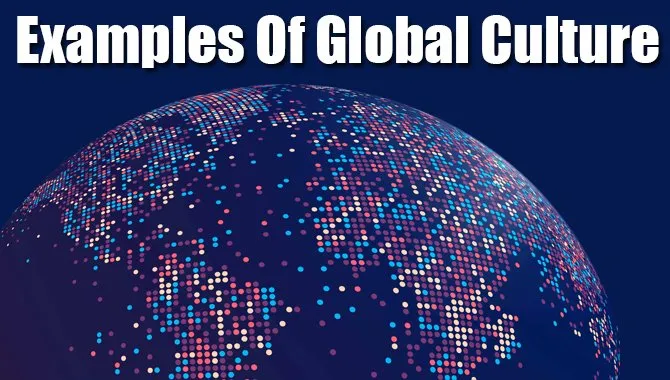Global culture refers to shared experiences, ideas, symbols, cultural products, and values across national borders.
“Examples of Global Culture: All You Need to Know” refers specifically to a new concept of a common and global mono-culture transmitted and reinforced by the internet, global brands, international tourism, books, and other mass media.
This concept transcends the cultural traditions, tastes, and everyday lifestyles of people around the globe. Culture can exist in the global, regional, neighborhood, super culture, subculture, and many other levels.
These levels of cultures are not mutually exclusive. Rather they share the same ideas. Some sociologists today predict the rapid changes in cultural diversity as a step closer to global culture.

The Examples Of Global Culture
The motto of global culture has been seen as a trend toward homogeneity. This will eventually make people experience culture essentially the same everywhere. Here are some common examples of culture.
The Internet

Information technologies have turned our existence upside down. The internet has already left a significant impact on almost everything we do. It has changed business, healthcare, communication, education, and even our daily lifestyles.
Its impact on sociocultural activities has taken people’s lifestyles to a new dimension. Undoubtedly, the internet benefits culture in various ways. It brings culture closer to more people. Advanced communication technologies brought significant changes to people’s cultural behaviors. Social media bring these changes forward.
This powerful tool highlights human behaviors as well as culture. Being a global platform, social media crossed all the cultural boundaries. Facebook and other social media connect people around the globe with different ideologies, beliefs, and cultures. People from different cultures meet and slowly turn the platform into a cross-cultural communication platform in social media.
Sharing beliefs, ideas, tastes, cultural products on these easily accessible platforms opened new doors to spread knowledge. The changes in social communication took the sharing of knowledge to the individual level and taught people to respect different ideas and beliefs.
Nowadays, people are even practicing new religions through the internet. The effects that the internet has on society and culture can be considered a unique form of culture.
Tourism

Tourism is one of the most important factors that impact cross-cultural interaction. Tourism brings both positive and negative impacts on cultures. But positive impacts dominate the negatives. Tourism generally impacts the environmental, economic, and sociocultural dimensions. Improved tax revenue and personal income, more employment opportunities, and increased living standards are the gifts of the economic effects of tourism.
Interactions between people of different tastes, languages, and races are the significant socio-cultural impacts of tourism. Tourism helps people share ideas, cultures, relationships to material goods, attitudes, and behaviors across national borders. As a result, this empowers the host communities to preserve their local culture, arts, crafts, and traditions.
Education

Education plays a vital role in sharing the messages of a particular culture. Cultures can have a huge impact on the education system as well. Culture is the social change of a particular time in society.
The role of education is to pass this message of change from generation to generation. Education trains the younger to share cultural views with people across the border while preserving its core values.
Education sheds light on society’s darkest taboos and brings positive changes in cultural values, making them more acceptable to people of other cultures. Education restores the unity of humankind by removing cultural lag and strengthening cultural values. Culture paves the way for education while education brings new tastes to the cultural values in life.
Business

Cultures have always enriched each other through trade, travel, and even wars. Merchants from the ancient ages are carrying traditions and beliefs from one land to another. People met new cultures through trade.
The caravans carried goods and new rituals, spiritual messages, symbols, and tastes to new lands. Even today, CEOs and HR leaders believe that culture takes people’speople’s ideas, innovations, behavior to a new dimension.
It is important to note that culture was one of the most important business topics of 2016. Trade not only carries culture, but culture itself is also a business issue. In the twenty-first century, people from various cultures with diverse beliefs and ideologies influence the new global business strategies.
Global brands targeted cultures as their strategies for success. Their marketing and advertising played a huge role in shaping society. Tons of business ads affect our sociocultural behaviors and change the way our purchasing decisions.
This is a powerful form of branding because these advertisements are engaging with people at individual levels. The effect of these brands is becoming a part of the culture rapidly.
On the other hand, culture has a remarkable effect on business too. A study shows that brands can become more relevant by embracing culture. Branding culture creates a positive image in society and ensures the longevity of a brand. Culture determines the success or failure of a business in today’s fast-changing world.
Cuisine

Food brings people together. Food patterns connect people to their cultural or ethnic group. In the twenty-first century, food industries play a major role in global economics.
From producing raw ingredients to packaging and labeling, food industries are connecting lives across the border. Nowadays, traditional cuisines are very popular in urban areas, thanks to social media and modern transportation technologies.
The incredible change in people’s lifestyles and food habits saved thousands of rare and traditional cooking techniques and recipes. This opened the doors for more employment opportunities and increased standards of living. People’s new food habits greatly impact preserving even the rarest cuisines and traditional food habits.
Sports

Sports have a unique way of making a huge impact on culture. It teaches us to make a difference in our everyday life. It trains society to overcome barriers in terms of social, ethnic, political, or personal aspects.
Sports also play an important role in upholding a nation’s core values. In the era of the internet, people are more health-conscious than ever. Living a healthy life is not enough. Some took “being fit” to a new level.
The youngsters are taking “fitness” as a passion. Games and sports generally promote a culture of fitness. On the other hand, global events such as the ICC cricket world cup, FIFA world cup, the Olympics, NBA, and others promote a specific culture that unites people at the global level.
Sports treats people from all walks of life equally. Regardless of rich or poor, black or white, players participate in a journey that abolishes social differences. Sports fans from around the globe enjoy the events as well as adopt a culture of unity.
Migration

Culture is an important subject to the study of migration. Migration is considered a crucial aspect of global culture. The migration process has been going on for centuries.
However, the recent migrations impacted cultural globalization dramatically. Technological advances in both transportation and communication technologies made the migration process easier than before.
People migrate to a new land for various reasons. People generally migrate to increase the standards of living, trades, missionary work, or military oppression. They not only migrate to a new land, but they also take their customs with them.
The sudden increase of population in an area impacts the local culture as well. On the other hand, adopting new cultures impacts the lives of immigrants. These mixed socio-cultural beliefs, values, and customs make a unique culture for the next generations.
Gamers

Video games, the name that takes us to the sweet days of our childhood. Video games are not limited to children anymore. People of all ages enjoy them nowadays.
A statistic from 2020 shows that there were more than 1.52 billion gamers in the Asia Pacific region. This gives us an idea of how large the industry has grown and how diverse the video gaming culture is!
The increasing number of players and mainstream acceptance of gaming culture indicates its effects on the culture. Video games have changed a lot of things, including our day-to-day lifestyles.
The impact is even visible in the education system. New gaming technologies are being used to teach children. These technologies ensure a better visual interface as well as easy-to-learn methods.
Educational games such as Brain Age help teachers and students to communicate in new ways. Video games themselves have become a form of culture. Super Mario Bros, Pac-Man, Nintendo Wii, and the likes made a separate fanbase.
Some video games created their community and subculture, such as the PUBG mobile or Free Fire battlegrounds, made a significant change in the subcontinental gaming culture. This even made a significant impact on the subcontinental mobile phones industries and opened new doors for video game streamers.
The increasing number of gamers and its benefits to other industries led to an acceptance as a form of mainstream culture.
Converging Global Consumption Patterns

As the world becomes increasingly connected, consumers are beginning to adopt global purchasing patterns in order to save on costs and find the best deals. This shift is particularly evident in the tech industry, where consumers are increasingly looking for products that are Made in China but sold in the United States.
The use of e-commerce platforms has also made it easier for consumers to find and purchase products from all over the world. This has led to a rise in the number of Chinese brands that are selling products in the US market. In fact, according to a report by Forbes, Chinese brands now account for more than 50% of all US online sales.
This trend is likely to continue as Chinese brands become better at marketing their products worldwide and American brands strive to compete by offering lower prices and better customer service. In short, global consumption patterns are converging, and businesses of all types are benefitting from this trend.
Commit To Culture As A Continual And Collaborative Effort
There’s no question that culture is an important part of any organization – it drives employee engagement and helps to foster a sense of community. However, it can be difficult to create and maintain a culture that is both desirable and sustainable.
To create a culture that is both desirable and sustainable, it is important to commit to it as a continual and collaborative effort. This means that everyone in the organization must be on board with the culture and its goals, and they must be willing to work together towards those goals.
It also means that the organization must constantly be creating new ways to celebrate and reward employees for their contributions towards the culture. This way, everyone in the organization will feel appreciated and encouraged to continue working hard in pursuit of the organization’s goals.
The Bottom Line
Global culture has a deep impact on the modern-day lifestyle, food, fashion, workplace, education, and almost all aspects of our lives. Our article “Examples of Global Culture: All You Need to Know” mainly focused on these crucial issues.
Social media, advanced technologies, pop culture, trade, and other countless factors boosted this sharing of ideas, beliefs, and values. With our growing interest in adapting to new cultural values, the world is rapidly moving closer to homogeneity.
FAQs
What Are Examples Of Global Culture?
There is no one-size-fits-all answer to this question, as different cultures have their own unique traditions and customs. However, some examples of global culture include the following:
Fashion – Styles in different countries tend to be very different, and fashion is often a reflection of the current social trends.
Music – Different styles of music are popular in different countries, often reflecting the cultural trends of the time.
Food – The cuisine of different countries can vary dramatically, and often reflects the cultural influences that have been brought in by immigrants.
Why Is Global Culture Important?
Global culture is important because it influences the way we think and act. It helps to shape our values and beliefs, and can have a significant impact on our lives. For example, global culture has a major impact on our sense of nationality, and can often lead to conflicts. It can also influence the way we view the world, and can sometimes affect our social interactions.
Global culture is important because it shapes the way people think and behave. It helps to create a sense of community, which can be incredibly beneficial in times of stress or emergency. Global culture can also help to create a more interconnected world, which is essential for the growth of business and the economy.
What Is Global Culture in Globalization?
Global culture in globalization refers to the culture that is shared by people around the world who have access to the internet. It is a result of the way in which the internet has shaped our society and our way of life.
Global culture in globalization is based on the idea that all people have the same rights and should be treated equally. It also believes that all cultures are valuable and should be preserved.
The way in which global culture in globalization is transmitted varies from person to person. Some people learn about it through their interactions with others, while others may learn about it through reading or watching media.
What Is Global Culture in Your Own Words?
Global culture is the sum total of the shared values and norms that exist throughout the world. It includes the customs, traditions, beliefs, and more that make people from different parts of the globe feel like they belong to a single community.
As a global citizen, it’s important to understand and appreciate global culture – not just because it’s a fun thing to do, but because it can play a big role in your life. For example, if you’re trying to find a job or settle down in a new city, understanding the local customs and traditions can be an invaluable asset.
Similarly, if you’re planning on traveling overseas, knowing some basic customs and expressions can make your travels much smoother.
In short, global culture is an essential part of our lives – we should all learn as much as we can about it!
What Are the Impacts of Global Culture?
There’s no one-size-fits-all answer to this question, as the impacts of global culture vary depending on the individual and the place they’re living in. However, some of the most commonly observed impacts of global culture include:
changes in social norms and values
changes in language and communication
changes in traditional values and beliefs
changes in economic systems
changes in political systems
changes in social networks

I’m a writer and blogger who loves to talk about entertainment, culture, and relationships. I love to share my thoughts and insights on these topics, and I’m always looking for new ways to engage with my readers. I’m also a big fan of learning new things, so I’m always exploring new areas of interest.
